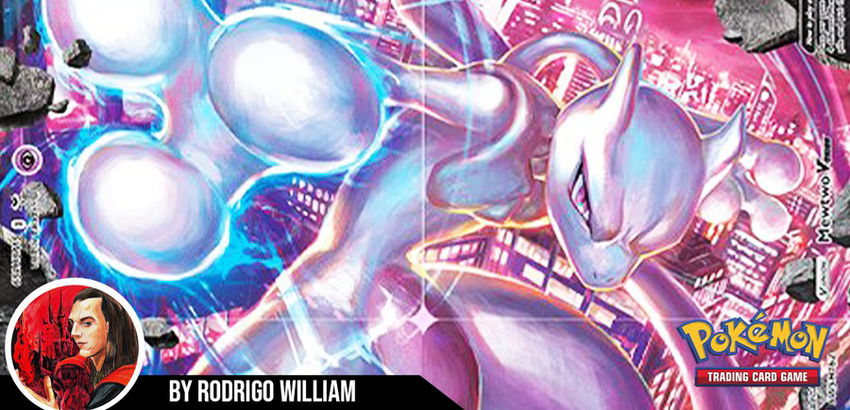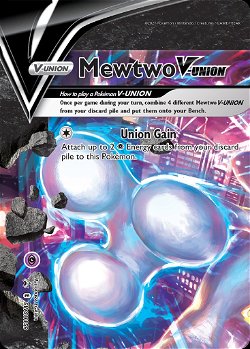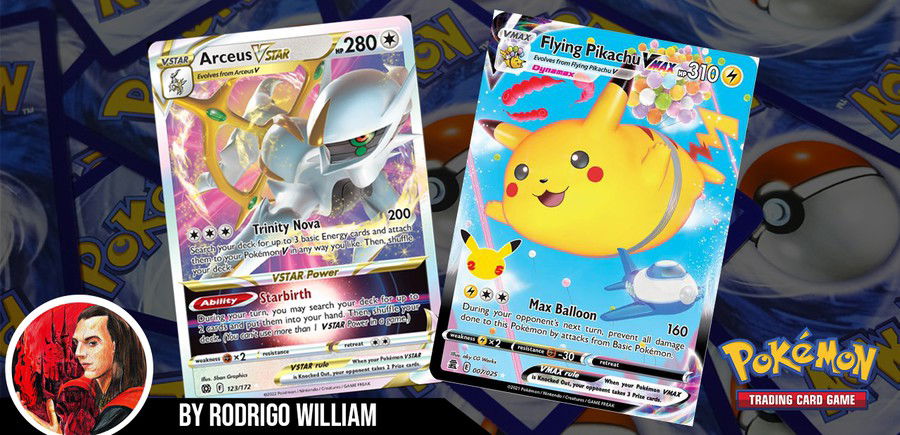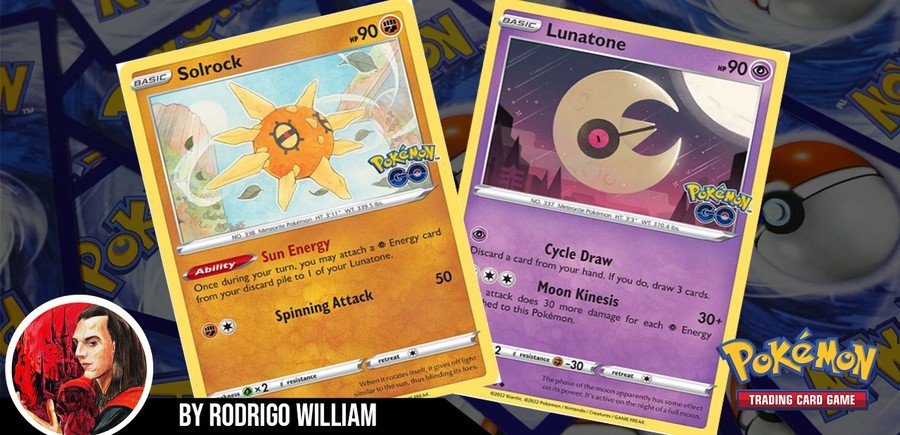Hello everybody. I'm Rodrigo, bringing more tips for building decks in the competitive format to inspire you to study the Standard format.
A few weeks ago, on the last weekend of June, there was the Pokémon International in the United States, considered one of the biggest Pokémon tournament events, below the World (of course).
And in this event, there was a very exotic player who brought a new mechanic and use for a V-Union card in the format (which is very rare to see) and amazingly, being in the top 4 in the event (being in 3rd place). That's why today we're going to talk about Sander Wojcik's Control-style Mewtwo-VUnion.
Ad
Mewtwo-VUnion Control Decklist
Deck Analysis
The deck's strategy consists of making several situational moves to respond to many adversities in the format, and as the deck's proposal says, "control" the opponent, taking possible resources from them with the discard of useful Trainer cards such as "Air Balloon", discard of use of normal energies such as specials, discards of Stadium cards, and situations where they can respond to some actions that can be countered. I will post some of them:
1) Slow the progress of attackers of type V Pokémon (either V, VStar, VMax or VUnion) of the opponent with Miltank ASR 126, which has the ability Miracle Body, which prevents them from taking damage from these types of Pokémon (which predominates in the format by 80%);
2) Discard the opponent's energies using the attack of Yveltal CEL 19, Cry of Destruction, which for two colorless energies (enters the use of the deck's Twin Energy RCL 174 for this purpose), you discard 3 special energies from the opponent (which is excellent for ending decks like Mew VMAX FST 114, that use a lot of Fusion Strike Energy FST 244), in addition to the Crushing Hammer SSH 159 flipping the coin to discard the opponent's energies, causing them to lose turns or even that specific situation of needing to use that energy to perform a key attack;
3) And of course, we have the star of the deck, which is the Mewtwo V-Union with its four parts (Mewtwo V-UNION PR-SW SWSH159, Mewtwo V-UNION PR-SW SWSH160, Mewtwo V-UNION PR-SW SWSH161 and Mewtwo V-UNION PR-SW SWSH162), which in addition to having a huge life total, 310 HP, has one ability and four attacks.

Mewtwo V-Union Ability and Attacks
- Its Photon Barrier ability ensures that Mewtwo is not affected by any effects of attacks from the opponent's Pokémon, for example, attacks that place special conditions on it.
- His first attack, Union Gain (C) (just like any V-Union), allows him to take two psychic energies from the discard pile and attach them to Mewtwo.
- His second attack, Super Regeneration (P)(P)(C), makes him recover 200 of his HP, which is not something to ignore.
- With its third attack, Psysplosion (P)(P)(C), Mewtwo can deal 16 damage counters between the opponent's Pokémon in any way you want, dealing what would be "indirect" damage, being able to evade Pokémon that use abilities that protect your opponent's Bench from direct damage, such as Manaphy BRS 41, if you want to attack your opponent's Pokémon.
- And his fourth and final attack, Final Burn (P)(P)(P)(C), deals 300 damage, which in addition to being a very welcome damage (no setback of energy discards like Charizard VMAX DAA 20 which has the same base damage, but at the cost of losing two energy, for example).
Deck Mechanics
Having said the main pillars of the deck, let's get into the mechanics so that the deck can rotate and engage this acceleration to be able to assemble the Mewtwo V-Union as much as possible.
Ad
How does V-Union work?
For that, you need to understand the V-Union mechanics.
Pokémon V-Union must have all 4 parts discarded in the discard pile to be played. However, it has some conditions: 1) it is not considered a "basic Pokémon", that is, you cannot use a Quick Ball FST 237 to look for it, being more ideal the Ultra Ball BRS 150, which doesn't focus on whether it is basic or evolution.
Also, if that Pokémon is Knocked Out, it gives the opponent three Prize cards. This Pokémon cannot return to the game again, meaning it can only appear once per game.
It is worth remembering, out of quick curiosity, that this “joining of cards” mechanic to be activated is not new. In the Heart Gold/Soul Silver block, there was the existence of the “Legends” cards, which were two parts of a Pokémon like Lugia LEGEND HS 113 — Lugia LEGEND HS 114 and Ho-Oh LEGEND HS 111 — Ho-Oh LEGEND HS 112), or a duo of Pokémon like Rayquaza & Deoxys LEGEND UD 89 — Rayquaza & Deoxys LEGEND UD 90. But in the case of LEGENDS, they could be played directly from the deck having both parts at the same time to play them, unlike V-Union, where it needs to be in the discard pile.
Acceleration Cards
Returning to the acceleration mechanics to assemble our Mewtwo V-Union, let's go to the different points, which can also directly or indirectly culminate in his search:

- Galarian Meowth RCL 126 is here for its Evolution Roar ability, where you discard two cards from your hand to look for another Galarian Meowth. The point of this ability is the possibility of discarding these two cards, precisely two parts of Mewtwo-VUnion.
So, with two Galarian Meowths, each discarding 2 parts of the Mewtwo-VUnion, you can build it in the first few turns. And for these Galarian Meowth not to be targets of the opponent as prize cards for some eventual knockout, after fulfilling their functions, the Item card Scoop Up Net RCL 165 serves to collect these Pokémon from the game to your hand.
- Ultra Ball BRS 150 is essential to search for Mewtwo parts and to speed up discards, taking out "bad" cards at the moment, that are dead weight or even creating combos like some Snorlax VIV 131 that is left over in the deck (when it has already fulfilled its purpose of drawing cards with its ability).
- For resource acceleration, we have two examples:
1) The aforementioned Snorlax VIV 131, with its Gormandize ability, where you can draw cards until you have seven in your hand, and if you do, your turn ends;
2) In addition, with the accelerated search for cards, we have the possibility of Pyukumuku FST 77, which with its ability Pitch a Pyukumuku, says that if it is in your hand, you reveal it and put it in the bottom of the deck as the last card for you to draw the top card of the deck. But you can't do this ability effect more than once on your turn.
- With the card Trekking Shoes ASR 156 you can look at the top card of your deck, being able to choose to take that card you saw and put it in your hand or discard it, which in this case can be a great situation. Let's say that one of the parts of the Mewtw V-Union is on this top, you can opt for the Trekking Shoes discard effect, thus speeding up its assembly.
Ad
And if any resource comes from a card that can be used as a support, some kind of Trainer, instead of losing it, you put it in your hand, preserving the useful time of the deck.
- And finally, Peonia CRE 149 is practically mandatory for any deck that uses V-Union, as it grants you the draw of the 3 prize cards you have and replaces it with 3 cards from your hand instead, basically as an “exchange”. You can guarantee to get any part of Mewtwo-VUnion that is in the prizes, so as not to compromise your game.
Trainer Cards
Now going to the Trainer cards part, let's break down their functions:

- Professor's Research BRS 147 needs no introduction: discard your hand and draw 7 cards, being one of the strongest in terms of draw power of any block. Assuming that in an occasional situation, you are in your hand with the 4 parts of the Mewtwo V-Union and can dispose of them at the same time with the use of “Professor's Research”, it's a sensational thing.
- Cyllene ASR 138 is the guarantee of recycling cards that you can use in control against the opponent because by flipping the coin 2 times and these two being heads, you can rescue these cards from the discard to put in your deck again. Generally, the ideal is always to rescue Crushing Hammer SSH 159, which serves to discard the opponent's energies.
- Peonia CRE 149 as said, is just the exchange of 3 prize cards for 3 cards in your hand, trying to filter and seek resources to move your game, such as Mewtwo parts, or some important card for the continuation of your game in some specific play.

- Flannery CRE 139 is for the control of discarding a special energy card and an opponent's stadium in play, which can thwart their game mechanics progression.
- Team Yell's Cheer BRS 149 was very expendable and well underestimated by 90% of the public, as it was considered a “meme” card and without much relevance, but it was a huge surprise in this deck.
How did Sander Wojcik think of using it? Shuffle a combination of 3 Pokémon and Trainer Supporter cards from the discard pile to your deck, being able to do recyclings like Flannery CRE 139 and Sidney FST 241 for control in that loop, and Boss's Orders RCL 154 to close some specific damage for a knockout.
- Here, Sidney FST 241 comes in as another strong control card, as it looks at the opponent's hand and in a two-card combination, the player is forced to discard Stadiums, Tools and special energies.

- Avery CRE 130 is precisely the terror of many decks in the current format, for precisely having control of the opponent's bench, discarding Pokémon until they have only 3 left, and still, you can draw three cards in the process.
That is, in addition to harming the opponent who uses massive draw tactics that use at least two Pokémon as a guarantee, such as Cinccino SSH 147 or Bibarel BRS 121, taking them out of play, and you still get to draw cards!
Ad
- Here, Cook FST 228 heals 70 damage from one of your Pokémon. It is primarily and exclusively for the HEAL tactic as a complement to the Mewtwo-VUnion's Super Regeneration attack, which heals 200 damage. Considering that you need to play a Trainer Supporter card before declaring the attack, in a hypothetical situation, you are healing 270 HP at once!
- Boss's Orders RCL 154 is practically essential in any deck, and needs no introduction due to its effect: they can pull an opponent's Benched Pokémon as an active, closing knockouts.
- Rose Tower DAA 169 is advantageous if your hand is low, as it allows you to draw cards until you have three in your possession. It can help in some resource reduction moment.

- Quick Ball FST 237 is used to fetch the basic Pokémon, both for the draw filter such as Snorlax VIV 131, Pyukumuku FST 77 and Galarian Meowth RCL 126, as well as Miltank ASR 126 and Yveltal CEL 19 as early game attackers.
- Ultra Ball BRS 150 goes more into the filtering case for the search for the Mewtwo V-Union parts and their discards, in its primary objective.
- The aforementioned Crushing Hammer SSH 159 is to discard the opponent's energies. And it can be combined with the Cyllene ASR 138 card loop for recycling.
- Trekking Shoes ASR 156 serves as a resource management and if possible, in a certain situation, you can discard parts of the Mewtwo V-Union at the top of the deck as quickly as possible.

- Scoop Up Net RCL 165 is used to collect some basic Pokémon that fulfilled its purpose and that, after that, is removed from the game to not be a dead weight, such as Galarian Meowth RCL 126 or Yveltal CEL 19.
- Pal Pad SSH 172 for recycling two Trainer Supporter cards from the discard pile to your deck, looping with control cards like Flannery CRE 139, Sidney FST 241, Avery CRE 130, for example, or even redeem a Boss's Orders RCL 154.
- Big Parasol DAA 157 prevents the effects of attacks from your opponent's Pokémon against your Pokémon that is equipped with it. Assuming if your opponent has any Pokémon that can have some effect against Mewtwo V-Union because it's a "V", for example if your opponent is a Decidueye DAA 13, your Mewtwo doesn't take damage from it.
- Cape of Toughness DAA 160 grants 50 more HP to non-GX Basic Pokémon, so it's good to attach to Miltank ASR 126 as an attacker against your opponent's Pokémon-V.

Of all Item Tool/Tool cards in the current format, every control deck must have Tool Jammer BST 136, as it inhibits the effects of Tool cards attached to the opponent's Pokémon, particularly Air Balloon SSH 156, which guarantees a generous retreat cost in the current format, breaking the opponent and having to force them to pay the energy cost to retreat and with that, being able to complement this combo with Crushing Hammer SSH 159 if that Pokémon is a "heavy" type of Pokémon, which requires a lot of energy to hit or retreat.
Ad
Format Archetypes
Advantages
As a Control archetype, our deck works with the opponent's patience to leave them with a wear of concentration, being in a bad situation to be able to fight back any control activity of energy, resources, stadium, or tools inhibition.
Basically, it's a kind of deck that works with patience, and it's very sustainable, as Mewtwo's healing makes it last a long time in the game, almost leaving the feeling that this card is some kind of indestructible "deity", making many opponents will fold if pressed too hard by this type of strategy.
Disadvantages
And like all psychic Pokémon, its weakness is to dark types, that is, Dark Box reigns against this type of deck. Cards like Darkrai VSTAR ASR 99, Galarian Moltres V CRE 97, Crobat VMAX SHF 45, Hoopa V FST 253 and Galarian Moltres EVS 93 have greater ease against it.
Also, if the deck can respond quickly, hitting as fast as possible with few energies with high damage that exceeds 300 and with zero recoil, such as Mew VMAX FST 114, these are situations that can give Mewtwo's deck problems.
Conclusions
It's a deck for those who like to control their opponent and see them get worn out with the damage to techniques they want to do.
But even having this great potential for use and instrumentality with the mechanical system, generally for playing control, it is necessary to understand the deck in-depth to know how to use these options as advantages in your favor and know how to dose where it is necessary to apply them, not being that simple deck in the traditional “more damage, less energy” mold.
But it is worth the investment and study for those who like this play style.










— commentaires0
Soyez le premier à commenter